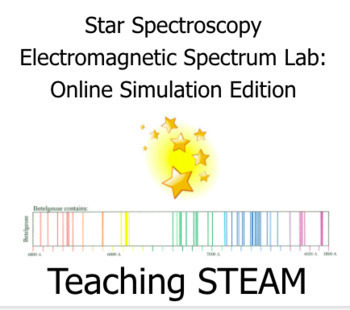Star Spectroscopy/Electromagnetic Spectrum Lab: Online Simulation Edition
- Google Docs™
- Internet Activities

What educators are saying
Description
Spectroscopy is how we know what elements are in stars. This lab is awesome connecting students to how star science works. It also makes spectroscopy real in chemistry class, physics, astronomy, and general science about the electromagnetic spectrum. My students loved this activity solo and over Zoom. They felt that they learned how we use spectroscopy and have a deeper understanding of the electromagnetic spectrum.
This activity is an online simulation version of Star Spectroscopy/Electromagnetic Spectrum Lab and is perfect for remote learners or if your school does not have the equipment.
I also like to go through the development of telescopes and begin with Build a Telescope Lab: Reflection and Refraction Fun!
You may also be interested in Modeling Fusion Activity.


